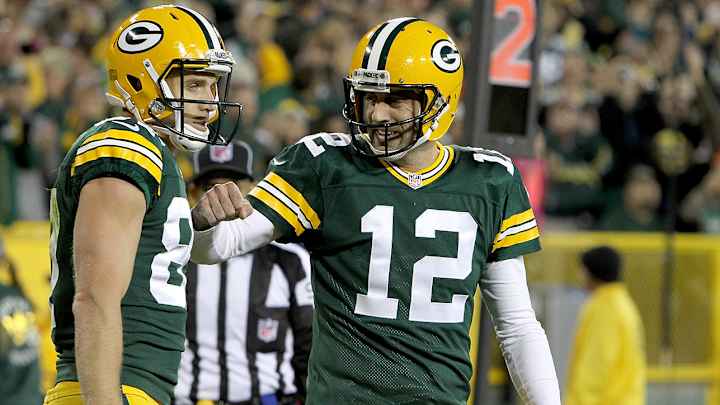Green Bay Packers: 10 Things You Need to Know

1. Aaron Rodgers is a paradox. At times he simply won’t look to the receiver that the play is designed for. He’ll hold the ball unnecessarily and break himself down in the pocket. And yet, when he does this, he not only avoids turnovers, he often makes spectacular plays. But without question, Green Bay’s offense operates better when Rodgers is playing on time and with discipline. That’s what he did down the stretch last season when he lit the world on fire.
2. Jordy Nelson is the perfect receiver for Rodgers. Besides running Green Bay’s staple routes—slants and posts outside, and deep “over” routes from the slot—Nelson is tremendous on the back-shoulder throws that Rodgers loves, and he has a feel for how to “uncover” when a play breaks down late. This is a big reason why 11 of his league-leading 14 touchdown receptions last year came in the red zone.
Monday Morning QB: Aaron Rodgers Never Wants to Retire (While Jay Cutler Changes His Mind)
3. Let’s not forget: A big reason Rodgers and Nelson are great late in the down is their offensive line allows them to get there. No front five was better at sustaining pass protection for prolonged periods in 2016—not even Dallas’s. Green Bay’s O-line does have some built-in advantages, though. Instead of blitzing Rodgers, defenses like to drop eight into coverage, so the front five is only blocking three defenders. Also, the Packers see fewer designer pass rush tactics like stunts and twists; defenses are so concerned with keeping Rodgers in the pocket, they tend to have pass rushers just go straight up the field.
4. When tight end Jared Cook played in 2016, the Packers were 10-3. When he didn’t, they were 2-4. Cook’s presence mattered because he could align anywhere in the formation, which brought diversity to Green Bay’s otherwise vanilla offense. By moving Cook around, it became easier to move around other flexible pieces like Randall Cobb, Ty Montgomery and the vastly improved Davante Adams. Cook signed with Oakland in free agency, but replacing him is Martellus Bennett, a similar styled receiver and better blocker.

5. It will be interesting to see Ty Montgomery in Year Two at running back. He’s shown flashes of keen vision and, while not Le’Veon Bell, he runs with patience. We know he’s valuable as a movable chess piece, but the Packers are hoping he can be a sustaining ballcarrier in the two-back ground game that Mike McCarthy often uses heavily to stabilize the offense.
6. You might have noticed during draft coverage, that when the Packers picked defensive backs Kevin King and Josh Jones in the second round, a beaming Dom Capers appeared in the war room to shake GM Ted Thompson’s hand. That’s because Capers, the team’s nine-year defensive coordinator, can run his actual system when he has cover artists he trusts. That system is comprised of inside linebacker blitzes and, as we saw at times last season, cornerback edge blitzes. Disguised coverage rotations are common behind both tactics.
7. Last season, we only saw snippets of Capers’s scheme. Most of the time, it was reduced to a cautious “2 man” approach (man-to-man with two safeties over the top). This was to aid floundering high-drafted 2015 cornerbacks Damarious Randall and Quinten Rollins. Even with King aboard and Davon House brought back in free agency, the Packers need at least one of these guys to rebound in a big way. Randall will get an honest chance after relocating to the slot. A safety at Arizona State, this is basically his third position in four years. He won’t get a chance at a fourth position.
8. The other guy who must rebound is Clay Matthews. The question is whether his disappearing act in 2016 can be attributed to injuries or age. The Packers are banking on the former. If a now-healthy Matthews doesn’t regain his electricity off the edge, this defense will be dependent on blitzing. Nick Perry, though coming off a career-year, isn’t enough to spearhead an entire pass rush on the other side.
9. Capers loves to play “big nickel,” even against running formations. He basically substitutes a linebacker for a smaller, but more athletic, box safety. Charles Woodson and Micah Hyde (now gone to Buffalo) both prospered in this role. This year, eight-year veteran Morgan Burnett should ultimately fill it.
10. When you play nickel all the time, your defensive linemen must really be destructive inside. The Packers have an excellent one in Mike Daniels, and last year’s first-rounder, Kenny Clark, flashed a bit down the stretch.
• Question or comment? Email us at talkback@themmqb.com.
